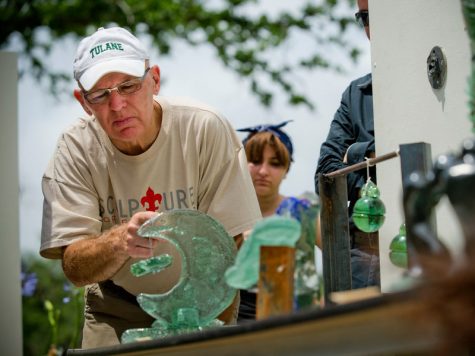Professor Spotlight: Gene Koss
April 21, 2021

Located in the Woldenberg Art Center, the Pace-Willson Glass Studio is home to Tulane’s world-class glass facilities which include a hotshop and a coldshop, as well as metalworking facilities. Working six days a week amongst the machines and instructing students is professor Gene Koss, a glass-sculpting legend and beloved Tulane professor. Koss has been the head of the glass program since 1976 and has built it from the ground up, but he is too humble to take all of the credit.
“We’re like a big family and we help each other,” Koss said of everyone involved. “The students take it really seriously too, so I feel really committed when a student takes a class.”
If there is anything that Koss has kept consistently throughout his career, it has been his drive. While instructing and running the glass department, Koss continues to work as a full-time sculptural artist. Koss’ most recent show, located at the Arthur Roger Gallery, ran from Jan. 9 to April 10, making it his 53rd one-man show. Koss said that it’s important to be both teaching and continuing with his own work, for everyone’s sake.
“I’m already thinking about my next exhibit that’s on the road, I think that I’m a better teacher if I’m creating because I’m struggling along with the students while I’m making my work, and they see that too,” he said.
Drawing on inspiration from his childhood, Koss takes the memories of his Wisconsin upbringing and transforms them into fantastic pieces of sculpture.
“I wanted to change glass. I wanted it to be sculpture, not just the craft part of it,” Koss said.
He has kept true to his word, as his pieces are larger than life and successfully marry both metal and glass work. One of his pieces, located outside of the entrance to the Woldenberg Art Center, exemplifies this wonderfully. The piece, entitled “Backhoe (2014),” masterfully captures both emotion and movement in materials that often suggest the opposite.
While most of Koss’s work draws on his life as a young boy in a small Wisconsin town, he also finds inspiration a little closer to home.
“Here, you can drive down St. Charles Ave. and be inspired by the architecture or the landscape,” Koss said. “The whole city is like one big sculpture in a way.”
Koss has lived and worked in New Orleans for over 40 years with his wife. After Hurricane Katrina hit in 2005, they both decided to come back and stay. Their love and respect for the city as well as Tulane has meant that the world is looking to the American South for glass-sculpture innovation.
“If you’ve seen my world-class studio down the river, it’s like a research center for Gene Koss where you’re shipping, building, research going on and it’s strictly for my world, I guess,” he said of his personal work space. “But Tulane is for everybody. And it’s also for the city too … we kind of set the pace for what goes on in the city. There’s a whole environment of glass art now that’s going on in the city.”
Tulane has long used its world-class glass facilities and rigorous glass studies department as a way to bring students into the arts. Because of this, there is a fear that these courses are only for experienced glass students, but Koss’ outlook on the program here at Tulane revolves around a model of inclusivity.
“I wanted it to be a serious school if you wanted to come work glass here … but also be open for people who just wanted to take a couple of classes maybe, and I think that’s important,” Koss said.
Koss has also dipped into the more scholarly side of things, as he published a book of his work in 2019. He said that constantly working towards your goals — whether that be publishing a book or simply working on projects — is an important part of being an artist.
“I just think that artists will set goals for themselves. There’s going to be downtime. You have to be able to get through the not-so-good times because the good times of making work are great,” he said.
Koss said that all of the glass classes for the next semester are full, proving how hard everyone in the department has worked to build the glass program into the powerhouse it is today. Koss does not plan on stopping this momentum anytime soon.
“My mother asked me before she passed, ‘Are you ever going to be satisfied?’ and I thought about that,” Koss said. “I’m satisfied, but I’m always pushing myself. It’s not as intense as it was when I was younger, but my drive for being a teacher and among work … it’s still there.”






















Leave a Comment